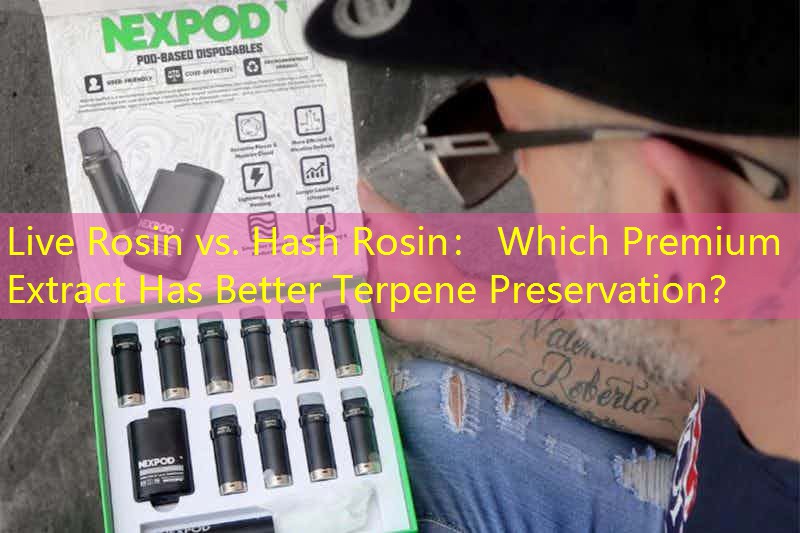라이브 로진 대. 해시 로진: Understanding the Premium Extracts
In the world of cannabis concentrates, 프리미엄 제품에 대한 논의에서 두 가지 이름이 자주 등장합니다.:
Live Rosin
그리고
해시 로진
. 이 추출물은 종종 그 맛으로 칭찬을 받습니다., 힘, 그리고 전반적인 품질, 하지만 많은 열성팬들은 어느 것이 더 나은 테르펜 보존을 가지고 있는지 궁금해합니다.. 이 기사에서, 두 가지 유형의 로진을 모두 살펴보겠습니다., 추출 과정을 자세히 설명, 맛 프로필, 그리고 궁극적으로, 테르펜 보존 능력.
The Extraction Process
The extraction methods for
Live Rosin
그리고
해시 로진
differ significantly, 최종 품질 및 테르펜 프로필에 영향을 미침.
– **라이브 로진**: 신선한 재료로 만든, 급속 냉동 대마초 싹, 생로진은 열과 압력을 이용해 꼼꼼한 추출 과정을 거칩니다.. The fresh flowers are frozen immediately after harvest, preserving the delicate terpenes that would otherwise degrade if dried. This process also means that live rosin retains a vibrant flavor profile synonymous with the strain used.
– **Hash Rosin**: This extract starts with dry sift hash, which is produced by creating a concentrated resin from dried cannabis flowers. The dry sift is then pressed under heat and pressure to create
해시 로진
. While this method also delivers a potent product, the initial drying and curing of the cannabis can lead to some terpene loss, which may affect the final flavor and aroma.
Flavor Profiles and Terpene Preservation
둘 다
Live Rosin
그리고
해시 로진
have unique flavor profiles based on their terpenes. 하지만, the way each type retains these terpenes is crucial for enthusiasts looking for an authentic experience.
– **Terpene Content**: 일반적으로, the fresher the plant material used in extraction, the higher the terpene content in the final product. Live rosin tends to showcase a fuller spectrum of terpenes, as the process preserves the natural compounds present in freshly harvested cannabis.
– **Flavor Experience**: Users often report that live rosin provides a more robust and complex flavor experience. The preservation of terpenes leads to a more aromatic and flavorful puff that highlights the original strain characteristics. 거꾸로, while hash rosin can still be very flavorful, it may not possess the same level of complexity due to potential terpene degradation during the drying process.
Comparative Analysis Table
| 특징 | Live Rosin | 해시 로진 |
|---|---|---|
| Extraction Method | Fresh, frozen cannabis | Dried cannabis (sifted) |
| Flavor Profile | Robust and complex | Potent but less complex |
| Terpene Preservation | 높은 | 보통의 |
| Overall Potency | 높은 | 높은 |
Which Is Better for Terpene Preservation?
When evaluating the extracts based on terpene preservation, live rosin emerges as the clear winner. The fresh frozen material utilized during extraction ensures that more terpenes are maintained, leading to a product that is richer in aroma and flavor. For those seeking an authentic and full-bodied cannabis experience,
Live Rosin
is the preferred choice.
Case Studies: User Preferences
In various user surveys and focus groups, preferences between
Live Rosin
그리고
해시 로진
have been expressed. Many participants noted that when it came to flavor and aroma, live rosin consistently ranked higher. 대조적으로, hash rosin was appreciated for its accessibility and price point but was often viewed as a secondary option to live rosin.

Common Questions About Live and Hash Rosin
What is the main difference in the extraction methods between Live Rosin and Hash Rosin?
The primary distinction lies in the starting material. Live rosin is extracted from fresh frozen cannabis, while hash rosin is made from dried and sifted cannabis. This affects the terpene content and flavor profile of the final product.
Is Live Rosin worth the price compared to Hash Rosin?
Many consumers believe that live rosin justifies its higher price point due to its enhanced flavor, aroma, 그리고 전반적인 품질, thereby providing a premium experience for enthusiasts.

Can I achieve similar flavors with Hash Rosin as with Live Rosin?
While hash rosin can still offer potent flavors, it typically won’t reach the same complexity and richness as live rosin, primarily due to the loss of terpenes during the drying process.







